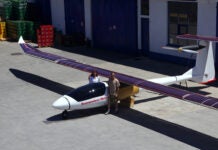KITPLANES Columnist Dean Sigler will be blogging from the Green Flight Challenge this week. Herewith, his first report on the entrants that arrived on Sunday.

The Pipistrel G4, with its twin motorglider fuselages and wide center section, supports a 145 kilowatt (200 horsepower) motor. The two pods can carry four passengers, occupants of neither crew compartment being able to see the other because of the intruding motor housing. The propeller is an elegantly curved, laminated wood design able to absorb the horsepower (most powerful electric motor flying on any airplane) and transmit the power to the air relatively noiselessly.

Eric Raymond’s e-Genius, a collaborative effort with Stuttgart University, mounts its electric motor on a stalk protruding from the vertical fin. The airplane, at least forward of the wing, otherwise looks a great deal like the Pipistrel Taurus, having been derived partly from that airplane.
Jim Lee’s Phoenix motorglider uses a Rotax engine to motivate it skyward, then can waft about on thermals without power. Lee has done 130-mile flights with the propeller feathered in this machine, and he and one of two copilots flew from Florida to Santa Rosa, California, for the event, making their voyage the longest by air for any of the competitors.

Embry Riddle Aeronautical University is fielding a modified Stemme motorglider that has a Rotax hybrid with an electric motor attached. The engine is used for takeoff and the motor for cruise flight, drawing down the current from batteries carried on board. Unfortunately, a discrepancy between University rules and GFC rules has kept them from competing, though they will fly demonstration flights on the same challeges as the viable competitors. (Embry Riddle does not allow a second pilot on board an Experimental aircraft, while CAFE rules require a second pilot in a two-seat craft.)

Weighing did not conclude until 8 p.m. on Sunday, and only for one airplane, Jim Lee’s Phoenix, a Czech Republic motorglider with a Rotax engine. It is the smallest of the competitors and the only pure gasoline-powered entry.
Monday, weighing was completed, with the CAFE scales getting a good workout from the unusually configured aircraft. Pipistrel’s crew brought an array of metal stands to allow their dual-fuselage G4 to be weighed. Nobody but weighing and aircraft personnel were allowed inside, because the scales are highly sensitive.
All four aircraft took part in the climb and noise challege Monday afternoon. All passed, clearing an imaginary 50-foot barrier at the end of a 2000-foot runway. Each was also remarkably quiet, with the e-Genius being the most whisper-soft of all.
Tuesday, all airplanes will fly the 200-mile GFC course, weather permitting.













